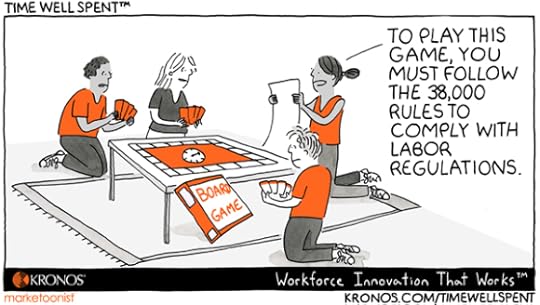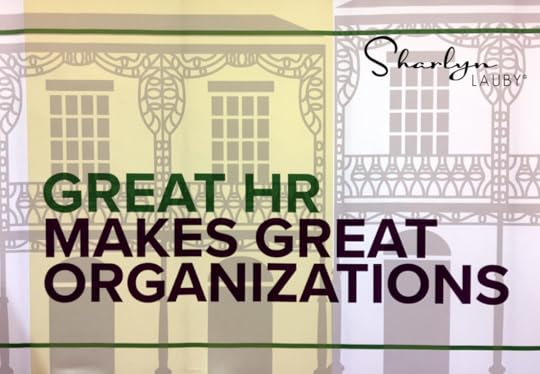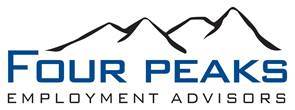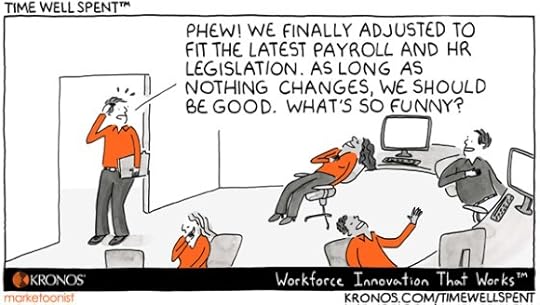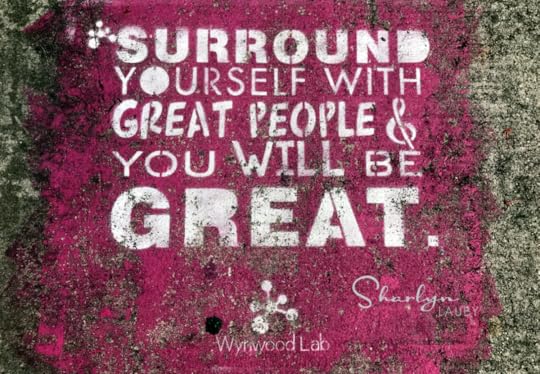Sharlyn J. Lauby's Blog, page 126
December 3, 2017
Making Company Culture More Than a Rah Rah Activity
Having a well-defined company culture is important. We talk about it a lot. Culture drives branding, talent acquisition, decision-making, etc. But sometimes, the discussions about company culture can seem a bit “rah-rah”. You know, a bit more qualitative and not enough quantitative.
I’m not saying that culture should be a 100 percent quantitative topic. In fact, my position about metrics and measurement has really evolved. For years, we’ve said HR needs to know the numbers. And that’s true, HR does need to understand metrics, data, analytics, etc. But storytelling is a powerful tool. I believe the best approach is to do both. Tell the story and back it up with numbers.
How can we apply this to conversations about company culture?
At this year’s Great Place to Work Conference, I heard a session with Viyas Sundaram, chief revenue officer at Snagajob, who I thought did a great job of connecting culture and metrics. He talked about the need to amplify company culture. Think of it like a megaphone. You have a culture. What are you doing to make sure it stays in the forefront of everything you do? To keep culture alive, it needs to be broadcast and measured.
Sundaram suggests that there are three steps to creating a culture “megaphone” strategy:
Think about the behaviors the company exhibits. Those are the behaviors that get magnified.
Think about the actions the company celebrates. Those are the actions that turn into habits.
Create a data point between the behaviors and the habits. That holds people accountable.
Organizations that are having conversations right now about their culture, might want to consider asking themselves about these three steps.
What are the behaviors that the company exhibits? Are they in alignment with the culture you seek?
What are the actions that the company celebrates? Is the company celebrating the right things (i.e. things that align with the desired culture)?
Finally, is the company reinforcing their culture enough? And are the right people reinforcing the culture?
It would be interesting to see if everyone in the organization is on the same page where company culture is concerned. Would everyone answer the questions the same way? And could they provide examples – clear, specific examples – of how the company’s words and deeds are in alignment with culture.
I believe it’s very easy to lose sight of company culture. Once it’s gone, culture can be difficult to get back. One person cannot carry the company’s culture megaphone. It’s something that everyone must agree they will do together.
Image courtesy of Deadpool – be sure to check out the latest trailer (and you should probably do it from home, just sayin).
The post Making Company Culture More Than a Rah Rah Activity appeared first on hr bartender.






December 1, 2017
Let Your Employees Know the Rules – Friday Distraction
Today’s media has a lot of talk about rules. Specifically, about breaking rules. Remember the Marcus Buckingham book “First, Break All the Rules”? In a world where disruption is often truly valued, knowing how and when to break the rules is essential.
And that’s the key – knowing how and when. Whether it’s one rule or a few thousand, today’s Time Well Spent from our friends at Kronos reminds us that every once in a while, we have to abide by the rules. If you want people to follow the rules, there are some basic things that need to happen.
Set expectations. This sounds so obvious, but in my experience, it doesn’t happen as often as it should. Rules, policies, procedures, guidelines, etc. must be communicated. Think about when employees need to know information and share the rules with them. It might be at orientation or during a training session.
Don’t assume. Organizations should not hand employees a binder of rules and assume they will read them all word for word. The reason they won’t isn’t because they don’t care. It’s because handing someone a binder of rules looks like the company doesn’t care. Organizational rules that are explained and discussed will come across as most important.
Explain the WIIFM. When it comes time to explain a rule, employees should understand why the rule is important to them (i.e. WIIFM = What’s in it for me?) People will follow rules when they know the reason it impacts them. And “because I said so” just isn’t good enough.
Disclose the consequences. In addition to sharing the reasons why employees should care about a rule, tell them what will happen if the rule is broken. On the front end. That way, if the rule is broken, the employee understood the consequences before taking action.
I realize there’s a quote that it’s “easier to ask for forgiveness than it is to get permission”. I’ve used that line before – more than a few times. But always when I thought I could get away with it. Meaning, I knew the rule, I understood how it impacted me, and I knew the consequences of breaking it.
When employees don’t have that information, it’s not fair to them. They’re being asked to assume consequences they don’t know for a rule that they’re unsure about. Rules aren’t as bad as they seem sometimes. We need them for safety and security. But the only way rules work is when everyone knows and understands them.
The post Let Your Employees Know the Rules – Friday Distraction appeared first on hr bartender.






November 30, 2017
Companies Need to Be Open To a New Definition of Family
I ran across an article in Workforce magazine recently titled, “How to Create a Single-Friendly Culture”. It’s a good read so you might want to check it out. The big takeaway for me was that organizations need to realize that employees have lives outside of work. They have people and things that are important to them. Employees want to know that the company will be supportive of those things that employees hold dear.
Please note: I didn’t say family. I’m not anti-family. I believe family-friendly policies are terrific. But everyone defines family a little differently. My guess is, if you asked ten employees, the people they would talk about are all a little different. It’s time for organizations to recognize that. Organizations should not tell employees who is part of their “family”.
If an employee calls to say their aunt passed away, no organization should say, “I’m sorry. Your aunt isn’t considered family under our bereavement policy.”
If organizations allow parents to leave work early to attend their child’s graduation, then an employee who wants to leave early because a close friend is graduating from college should be allowed the same.
If someone who is married (or a parent) can say they’re not able to travel or work nights or weekends, then single employees should be given the same consideration.
An employee’s marital or parenting status should not be driving employment decisions. (NOTE: In some situations, using marital or parenting status can be illegal. Check with your friendly employment attorney for details. That’s not the focus of today’s post.) Company policies that mention family should be written to be more inclusive. Employees should not be treated differently based on their definition of family. Organizations have an opportunity to revisit their workplace policies and make them more inclusive. And I believe candidates and employees are looking for companies to do this.
Redefine “family”. Have an internal discussion about not only being a family-friendly workplace but what family should mean for your organizational culture.
Revisit policies. Do an audit of internal policies and procedures to make sure that they align with the company’s open definition of family.
Reiterate your support. Let employees know that the company supports them. And wants them to enjoy time with their family, whoever that might be.
As companies spend more focused energy and resources toward developing family-friendly policies, it’s important how family is defined. Mom, dad, and 2.5 kids isn’t an acceptable definition anymore. Honestly, it’s probably never been an acceptable definition. Let employees help with this. They already help to define and sustain the company’s culture. They can do this too.
P.S. I just learned about a terrific last-minute professional development opportunity and wanted to share it with you. The Society for Human Resource Management (SHRM) is offering two seminars in Miami next week:
Mastering Your HR Generalist Role (December 5-6, 2017)
SHRM Certification Preparation (December 4-6, 2017)
HR Bartender readers can receive a $200 discount on these two offerings using the promo code 17SEM200. And if great education, recertification points, and a discount haven’t swayed you yet . . . I’ll tell you that the weather has been beautiful in Miami lately. Oh, and it’s stone crab season (if you’re into that sorta thing).
The post Companies Need to Be Open To a New Definition of Family appeared first on hr bartender.






November 28, 2017
How to Get To the Root Cause of Employee Engagement Issues
(Editor’s Note: Today’s article is brought to you by our friends at Workify , a tech-enabled service that helps companies establish more real-time feedback loops to uncover hidden engagement issues. Enjoy!)
Employee surveys are important. I’d like to think we all agree that asking employees for their feedback is valuable. However, the real impact of a survey is in what companies do with the data they receive. It’s the actions that organizations take as a result of the survey that tells employees the feedback they provided was valuable. But the only way companies can take action is by getting detailed, specific information.
Chances are that will not come directly from a single survey.
I’ve always said that employee surveys start conversations. They don’t finish them. Even the best designed surveys can struggle to anticipate the follow-up needed to get specifics. That’s why setting a baseline is important, then going past that baseline to get more additional feedback is necessary.
4 Common Organizational Concerns (and How to Address Them)
When it comes to getting specifics, it’s important to ask the right follow-up questions. The last thing you want is to ask a question that intentionally gets the response you’re looking for. Not only do you run the risk of confirmation bias, but the organization will not get clear information. Remember the old saying “garbage in, garbage out” (GIGO). It’s really more than just computer jargon.
Let’s take four common organizational concerns like communication, management, misalignment, and change management. These are challenges that most companies struggle with and almost all employees would have opinions on these topics. For each, we can talk about what organizations might ask to get that additional feedback they need to take action. Because it’s the detail that will point the company in the right direction.
#1 COMMUNICATION: Every single organization needs to communicate well to accomplish their goals. Every single employee needs to communicate to perform well. I don’t need to spend a lot of time talking about the importance of good communication. But we all know that communication isn’t perceived the same way. The baseline survey feedback could indicate there are communication issues but then the question becomes what kind of communication issues. Is it a lack of transparency or that communications are poorly timed or maybe that messages just aren’t clear and understandable?
To make sure that the organization focuses its efforts in the right way, they can include a follow-up item such as “I get the information I need from my manager to be effective in my role.” Employees have the opportunity to provide the additional information that might lead the organization to understand that developing a better communication rhythm (i.e. better timing) is what employees are looking for.
#2 MANGEMENT: Almost all of the work that happens in the organization happens through management. Managers are responsible for planning, organizing, staffing, coordinating, and controlling the work. That’s why engagement survey items are designed to receive feedback about management. But the words “manager” and “leader” can be interpreted differently. In my experience, the survey wasn’t designed to be intentionally vague or to trick the employee. People just read and interpret the item differently.
If the baseline survey results report that management is inconsistent or untrained or look like they’re stressed, then the organization needs to have a better sense of who those comments are about – front line supervisors, department managers, C-level leaders, or everyone. Including a follow-up item such as “My manager challenges me to improve.” could provide additional clarification and feedback about not only “who” but “where” the focus needs to be. For example, if the company needs to provide management development, what should be included in the program?
#3 MISALIGNMENT: This is also a good time to point out that the themes we’re talking about don’t stand alone. It’s possible that managers have issues communicating, which adds a whole new dimension to the employee engagement conversation and what the potential solutions might be. For instance, if the baseline survey results show misalignment, is it because policies and culture don’t match OR communications and culture don’t match OR performance and communication doesn’t match. All point to misalignment but can manifest themselves differently in the workplace.
The organization might want to follow-up by asking, “What one change would improve your confidence in the future of our organization?” Responses could signal the need for an employee recognition program that creates alignment between culture and communication. Another option might be the need for a more formalized goal-setting process to align performance and communication.
#4 CHANGE MANAGEMENT: Everything we’re talking about involves change. And employees will openly and honestly give their feedback when they think something will change. Trust is a key ingredient in employee surveys. Organizations need to pay attention when baseline survey results show that employees don’t feel that their voice matters. They might believe the organization is either hesitant to implement change, incapable of prioritizing changes, or poorly equipped to execute action plans. Or all three!
It could make sense to include a follow-up item such as, “I am excited about where the company is going.” to get a greater understanding of what employees think about the company’s future. It might also prompt additional employee feedback sessions or the creation of a suggestion program.
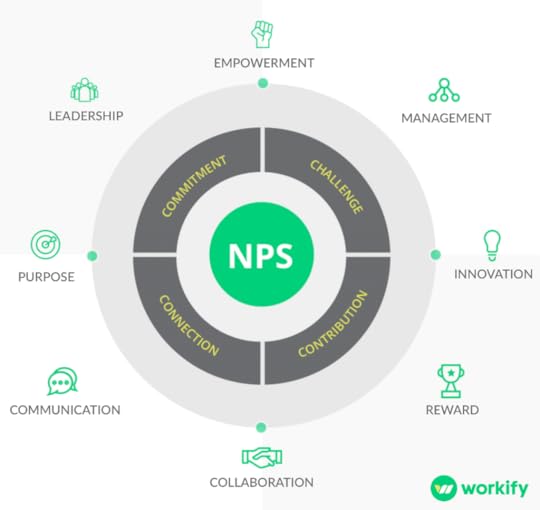
Use Follow-Up Surveys for Greater Understanding
Conducting a baseline employee survey is the first step in the process. When organizations see changes in their baseline data, then they can take steps to find out specifics they need to implement real change. Some companies choose to do this through focus groups and action committees. While these efforts can be successful, they can also drain resources, quickly get hijacked by loud individuals, and end up not providing a whole lot of value.
Deploying follow-up items through a second pulse survey enables organizations to go back and diagnose the issues in more detail. Companies can ask specific questions (both quantitative and qualitative) to better identify the key issues, and crowdsource ideas to improve engagement. And you get the added benefit of showing your employees that you are listening.
The overall success of any survey is based on the action taken from the survey. The only way you can take the right action is by understanding the specifics.
P.S. You can read more on how to quickly identify organizational concerns and get specifics out of surveys in Workify’s Engagement eBook, “3 Step Guide for Taking Action on Employee Feedback”. It’s well worth your time.
The post How to Get To the Root Cause of Employee Engagement Issues appeared first on hr bartender.






November 26, 2017
How to Resign From Your Job Properly
Over the years, we’ve spent a lot of time talking about the right way to get a job. I think it only makes sense to talk about the right way to resign when you leave a job. Because there is a right way to do it.
Even if the organization is terrible and your boss is a jerk, it’s important to resign the right way. That doesn’t mean you can’t be honest and authentic. Remember – you’re resigning. You’ve initiated this action. So, think through how you want it to happen. Here are a few things to consider:
Think about the reason you’re going to cite. My guess is there are lots of reasons you’re leaving. It could be pay, benefits, the company, your manager, the commute, and the list goes on… The company is going to ask you why, so think about the top 1-2 points you would like to communicate. Be selective and strategic in your response.
Write a resignation letter. At some point, the company will want formal documentation that you’re planning to leave. It’s possible to give verbal notice then follow-up with a letter. Resignation letters do not have to be long and they do not have to contain specific details. But they are expected.
Give proper notice. Whatever your company says is proper notice (two weeks or three weeks or a month), give it. Your new employer should not ask you not to give proper notice. They would expect you to give them proper notice if you left them.
Be prepared to leave. Some organizations will ask people in highly competitive roles to leave the day they give notice (common example: sales representatives). It’s not personal, they do it for everyone. Chances are you have already witnessed this around the workplace. If you’re in one of those roles, be prepared.
Don’t expect a counter-offer. It’s possible (but highly unlikely) that your company will give you a counter-offer and beg you to stay. There are a whole bunch of reasons why companies shouldn’t give counter-offers and why you shouldn’t accept one. The best strategy is not to expect one.
Find out about benefits and final paychecks. While you’re still there, find out about final pay checks and expenses, 401(k) plans, and health insurance (COBRA). Many HR departments have some sort of FAQ that they provide exiting employees with this information.
Help your replacement. If your boss hires your replacement (or designates a couple of co-workers to handle your work), be helpful and show them the ropes. They will not be like you. But you’re leaving. You’ve done a good job so far and you should want them to be successful.
Participate in an exit interview. If the company asks you to do an exit interview, do it. But this is where #1 is important. Know what you’re going to say about your work experience, your boss, and the company. There’s a way to be truthful without burning a bridge.
Return all company property. I know this seems obvious, but I’ve seen exiting employees use this as a way to ‘get back’ at the company. If you have computer or phone equipment, return it in good condition. Make sure that the company gets any keys or badges.
When you resign, it can be a stressful and exciting time. You’re trying to wrap up things at one job and start another. Resigning the right way allows you to focus on your new opportunity. It also sends the message to your co-workers that you wish them well.
Image captured by Sharlyn Lauby after speaking at the SHRM Annual Conference in Washington, DC
The post How to Resign From Your Job Properly appeared first on hr bartender.






November 21, 2017
Bookmark This! Resources to Develop HR Competencies
Developing your skills as a human resources professional is important. We know that. The hard part is recognizing what skills to develop.
At this year’s Society for Human Resource Management Annual Conference (SHRM), I ran across some wonderful tools to help with developing HR competencies. These guides offer suggestions for specific activities that HR pros can do to develop their skills. SHRM has given me permission to share them with you directly (free PDF downloads).
SHRM’s Top 10 Activities for Developing within the EARLY CAREER Level
SHRM’s Top 10 Activities for Transition from the EARLY TO MID CAREER Level
SHRM’s Top 10 Activities for Developing within the MID CAREER Level
SHRM’s Top 10 Activities for Transitioning from the MID TO SENIOR CAREER Level
SHRM’S Top 10 Activities for Transitioning from SENIOR TO EXECUTIVE CAREER Level
SHRM’S Top 10 Activities for Developing within the EXECUTIVE CAREER Level
Let me share three ways that I would use these documents:
Don’t make assumptions about your level. We can cut our development efforts short by making assumptions about our career level. I know people who say, “I’ve been in HR ten years so I’m a senior level professional.” And that might be true. However, these guides were developed for a mass audience so there are activities in the early career document that apply to everyone. I would suggest looking at all of them.
Share them with colleagues. If you’re mentoring or coaching an HR professional, these are great suggestions for professional development of HR competencies. You can bookmark this page and send it to colleagues when they ask about trying to get a promotion or transfer. It could be a great conversation starter.
Share them with your boss. I’m not implying that you should tell your boss they need to get some skills. (As tempting as it may be at times.) But, if you’re trying to justify attending a conference or acquiring additional training, think about using these in your pitch.
Speaking of pitching professional development of your HR competencies, I also found two other documents that you might find helpful.
SHRM Competency Development Plan for Mid-Career HR Professionals
SHRM Competency Development Plan for Senior Career HR Professional
What I like about these two guides is that there’s space to jot down some ideas and keep track of your progress. The guides were customized for SHRM’s 2017 conference, so they have presentation suggestions in them. While the conference is long gone, you can access sessions via SHRM’s eLearning Library. Something to consider.
If we want to be recognized as a business partner, we have to stay current and relevant. That means making investments in our career. But it’s very easy to spend money and time on professional develop without seeing results. Staying focused on activities that align with HR competencies will help us succeed.
Image captured by Sharlyn Lauby after speaking at the 2017 SHRM Annual Conference in New Orleans, LA
The post Bookmark This! Resources to Develop HR Competencies appeared first on hr bartender.






November 19, 2017
How to Handle a Work Suspension – Ask #HR Bartender
As a human resources professional, I have suspended employees. It didn’t happen very often, but it did happen. Because it wasn’t a regular occurrence, I was extra cautious to make sure that it was handled properly. So I can understand how difficult it must be for the employee – they don’t know what to do. That’s what today’s reader is trying to figure out.
Hi. I’ve been suspended from work for four months. To date, I haven’t been scheduled for the investigatory meeting.
There has been lack of communication and correspondence. I’ve received no further details regarding evidence or witnesses except what I was briefly told on the day of suspension. According to the policy in the employee handbook, I should have received a reply. I sent an appeal of the suspension and haven’t received a response.
Is there something I can do? This is causing me extreme physical and mental health problems. Have my employer and HR failed me? Please help! Thanks.
I don’t have to tell you that there are always two sides to every story and, obviously, we don’t know all the details in this situation. So, we can’t answer direct questions. But there are some things that we can talk about when it comes to suspensions and investigations.
To help us understand more, please welcome Marc Alifanz, principal at Four Peaks Employment Advisors. Marc and I are connected on LinkedIn and I’ve noticed that he writes super helpful stuff so I asked him if he would assist. Thankfully, he said yes. Even though Marc is an attorney, please remember that his comments should not be construed as legal advice or as pertaining to any specific factual situations. If you have particular detailed questions, they should be addressed directly with your friendly neighborhood labor attorney.
Marc, I’ve received a few reader questions lately about suspensions. I’ve always viewed them as a “last resort” option. What is a suspension and why would a company suspend an employee?
[Alifanz] Suspensions are a period of time where an employee is required by the employer to be out of work for some specific reason. Suspensions can take all sorts of different forms. Some are paid; most are not. Some are for a defined period of time, while others are not.
While there are many different reasons an employee may be placed on suspension, most suspensions fall under one of two categories:
As a punishment for violating a work rule; and
As in our question above, time off while the employer investigates an alleged serious violation of company policy.
Suspension as punishment is generally straightforward. Often companies will have policies that dictate a failure to follow certain rules or workplace norms will result in some form of discipline. It could be a counseling or a written warning, but as the offense increases in severity, it can also take the form of a suspension without pay, or a termination of employment. The suspension in this case is basically the workplace equivalent of sending a child to their room to ‘think about what they’ve done.’ And, not get paid for time they’d otherwise be working.
Investigation suspensions are a bit more open-ended. Let’s use a brief example: Employee in a machine shop is accused of violating a known and very serious safety rule. The employee denies it. At this early stage, we don’t know if there are any witnesses or other evidence that will help us determine if she did it or not. But, importantly, if she DID do it, we wouldn’t want her working there anymore, and don’t want to take the risk of having another incident happen. So in this case, I’d recommend a suspension pending an investigation. Once complete, and we form our conclusions, we bring the employee back, or not.
And one last note: Suspensions for investigations are generally unpaid. But I will often advise clients to keep the investigation short, and if the allegations are unsubstantiated, to pay the employee for the lost time.
The reader talks about non-responsiveness after being suspended. That could be the case here, but we don’t know for sure. When it comes to investigations, can managers or even HR be held personally liable if they fail to handle an investigation properly?
 [Alifanz] Let’s get all nerdy and Latin-y for a moment. You ask about personal liability. Personal liability is different from the company’s liability. By that I mean, a company’s liability is much easier to establish than an individual’s. That’s because of a concept called respondeat superior – literally translated as ‘let the master answer.’ Essentially, this concept means that an employer is responsible for the acts of its agent that occur in furthering the work of the employer.
[Alifanz] Let’s get all nerdy and Latin-y for a moment. You ask about personal liability. Personal liability is different from the company’s liability. By that I mean, a company’s liability is much easier to establish than an individual’s. That’s because of a concept called respondeat superior – literally translated as ‘let the master answer.’ Essentially, this concept means that an employer is responsible for the acts of its agent that occur in furthering the work of the employer.
So, in the situation of investigations, unless the manager or HR has acted in a way clearly outside the scope of their employment (rare), it is extremely unlikely that they can be held personally liable for failing to administer an investigation properly. Two quick caveats:
This does not necessarily mean that the employer itself will be immune from liability for botching an investigation, though I’d say it’s rare.
This also does not mean that the individual manager won’t be named in the lawsuit. But don’t fret! This is often done by plaintiffs for procedural reasons to keep cases in a certain court system that they find advantageous. While I can’t say it never happens, I have personally never had a case in the employment context where an individual defendant was found personally liable.
The reader note also mentions the employee handbook. Should handbooks include disciplinary processes? Why or why not?
[Alifanz] Traditionally, handbooks have been viewed as laying out all the rules and regulations of an employer, and as such, they would go into great detail regarding disciplinary processes. While many employers prefer that, and still have that (which is fine!), many are moving toward handbooks that are as much about defining company culture as they are about rules.
Personally, I’m not a fan of handbooks that outline on every page all the ways an employee can be fired. It’s not engaging for employees, and puts them in fear from day one. I prefer handbooks that address discipline in one spot with a catch-all. That catch-all may be light on detail or very specific, depending on the company’s needs. I’m generally fine with it so long as:
They apply the policy consistently; and
They write it in such a way that it gives them some wiggle room, as I’ve found over time that rules and reality don’t necessary always work well together.
We don’t know if the employee has been suspended with or without pay. In my experience, employees have been suspended for days (not months). If the employee isn’t receiving pay, this could cause a financial hardship. Do employees have any options? If so, what are they?
[Alifanz] Well, unless the policy specifically discussed the employee’s rights in this regard, which most won’t, the employee’s options will tend to be limited. If the suspension goes on endlessly, they may want to get searching for a new job.
That said, all employers should try to allocate sufficient resources (and I know this is hard) to investigate serious incidents quickly and efficiently, so that employees aren’t off work for more than a week or two just sitting in limbo. Sometimes it can be hard to move quickly given limited availability of witnesses, but it’s better for everyone involved when you wrap up your investigation quickly.
The employee mentions physical and mental health problems. Again, we don’t know the specifics, but can something like this expose the company to additional liability?
[Alifanz] In very limited circumstances, it could. Generally speaking, anyone placed on suspension is going to feel some amount of emotional distress, whether they committed the act or not. And if the suspension itself was done lawfully, any emotional distress that comes from it will generally not be something that exposes the company to liability.
Off the top of my head, I can think of two kinds of examples where it might:
Where the suspension itself occurs as the result of some form of illegal discrimination. If, for example, an employee can credibly claim that the employer only suspended him because of his protected class, like race, then the suspension itself could be actionable. In that circumstance, the employee could potentially receive compensation for the emotional distress that occurred as a result of the investigation.
If an individual levies an outrageous and untrue claim against the employee – especially as part of a campaign of hostility against the employee – resulting in the employee’s suspension, that individual or the company could be subject to a claim for Intentional Infliction of Emotional Distress (IIED). IIED claims are often brought as add-ons in litigation, but the standard required to find liability is so high that they are rarely successful.
A HUGE thanks to Marc for sharing his experience with us. Be sure to check out Marc’s Hostile Work Environment Podcast.
Employee suspensions are not an action that should be taken lightly. Companies need to make sure they are handling the matter properly, both from a legal perspective and from a respect standpoint.
Image captured by Sharlyn Lauby exploring the streets of Havana, Cuba
The post How to Handle a Work Suspension – Ask #HR Bartender appeared first on hr bartender.






November 17, 2017
Managing Change Is an Essential Skill – Friday Distraction
(Editor’s Note: Today’s article is brought to you by our friends at Kronos , a leading provider of workforce management and human capital management cloud solutions. Kronos is celebrating their 40th anniversary this year along with the opening of their new global headquarters. Many congratulations to them! Enjoy the article!)
We all have our favorite quotes about change. My personal fave is from Robert C. Gallagher, former director of the Green Bay Packers, “Change is inevitable-except from a vending machine.” I think one of the reasons that I like Gallagher’s quote is because it’s funny. And when it comes to change, we often need to keep our sense of humor.
Like in today’s Time Well Spent from our friends at Kronos. Change is hard. Even when it’s a change we want, it can be difficult. That’s why managing change is such an important competency. It’s also essential that we develop enough self-awareness to understand how we personally manage change, so we can help ourselves though the process.
Understand our personal triggers. I think this one is tough. Sometimes the stress of change can sneak up on us. One minute, we think that we have everything under control and the next, we’re freaking out. I’m a fan of Lewin’s change model for this reason. It only has three stages: Unfreeze – Change – Refreeze. It allows me to spend extra time thinking about the “Unfreeze” stage so I realize how many obstacles might end up in my way.
Practice self-care. I recently wrote an article over on The Workforce Institute blog about this. An increasing number of organizations are encouraging employees to practice self-care (aka “taking care of themselves”). Especially during times of change, finding a few moments to do something that’s good for our body and mind can make all the difference in the way we process change.
Don’t be afraid to ask for help. We don’t have to manage change alone. Finding a friend or colleague to talk with can be valuable. Sometimes we simply want someone to tell us that the way we’re feeling is normal – even if nothing can be done to fix the situation. Or having a laugh about something that happened during this time of change. Yes, change can be funny. Sharing with others can make us feel better (and help others as well).
Celebrate successes. Believe it or not, at some point, you’ll emerge from the change. Take time to celebrate! Maybe have a team celebration along with a group debrief. Or if it’s a change that you went through privately, take a moment to congratulate yourself. I mean, really do it! There’s nothing weird about patting yourself on the back. More people should do it.
Learning how to manage change is one of the most valuable competencies that individuals can develop for themselves. Organizations should consider a short session on managing change for all employees – maybe during onboarding. Because as Heraclitus said, “The only thing that is constant is change.”
The post Managing Change Is an Essential Skill – Friday Distraction appeared first on hr bartender.






November 16, 2017
Realistic Job Previews: 5 Questions Recruiters Should Ask
Candidates are researching organizations before they ever apply for a job opening. According to an article on Jibe, 76 percent of candidates do their own due diligence when conducting a job search. Instead of viewing this as a negative, organizations should use this as an opportunity to make sure the information out there is the information you want candidates to know about you and the jobs you offer.
For example, organizations can give candidates a “sneak peek” into what it’s like to work at the company by using a realistic job preview in their recruiting marketing strategy. Now, I know what you’re thinking, “We’re not perfect.” And you’re right. Every company has some negatives. No one likes putting their bad side out there.
Companies have the chance to be strategic about offering candidates a glimpse of what it’s like to work there and allowing the candidate to opt-out should they so choose. That’s not a bad thing…for anyone. But for realistic job previews to do what they’re intended to do, here are five questions to ask yourself:
1. Is the realistic job preview about the company or the work (or both)? Realistic job previews deal with two things: 1) the work itself and/or 2) the way work gets accomplished. Be intentional in what you’re trying to get across.
2. What do you we want candidates to know? “Everything” is not the correct response here. A realistic job preview isn’t a substitute for orientation, onboarding, or training. Identify the tasks or responsibilities that you want to make sure candidates know about the job.
3. When is the best time to share your information with candidates? Once you’ve identified those things you’d like for candidates to know, consider when it’s best to share this information – before applying, during screening interviews, or during in-depth interviews.
4. Who is the best person to share that info? Information can come from HR or the hiring manager (or possibly both). If the company does collaborative hiring, maybe it should come from a future colleague. Or it could be something you want every candidate to see, so it should be in a video on the company career site.
5. What’s the answer you’re looking for? It’s one thing to give candidates a realistic job preview. But organizations need to get a response from the candidate. The hiring team needs to reach agreement about the best way to evaluate the candidate’s reaction.
One of the real-life examples that comes to mind when I think of realistic job previews is a video from Google meeting. Not only does it share information about search for Google users, but it shows how meetings happen at the company. Personally, I think you can tell a lot about a company by sitting in one of their meetings.
I also read an article recently titled “Meet Your Future Office Via Virtual Reality”, where project designers are using virtual reality (VR) technology to show clients their office space before it’s ready. Wouldn’t it be cool if this idea extended to candidates? A job candidate would be able to walk around like they were actually in their own workspace.
Realistic job previews allow companies to share important aspects of the job and the company culture with candidates, hopefully before they apply. That way, there are no surprises later in the hiring process, which can ultimately increase employee retention.
P.S. I’m very excited to be speaking about manager onboarding at this year’s Recruiting Trends & Talent Tech conference being held in November at the Palm Beach County Convention Center. With recruiting being both a challenge and a top priority for companies, this is one show you do not want to miss. HR Bartender readers get a $100 discount on premium passes to the event.
The post Realistic Job Previews: 5 Questions Recruiters Should Ask appeared first on hr bartender.






November 14, 2017
Companies Don’t Have to Get Employee Feedback About Everything
I’ve always said that one of the worst things organizations can do is ask employees for their feedback and then do nothing with the information. As a human resources professional, this is one of the major gripes that employees have with employee surveys. (Side note: The length of time it takes to hear the survey results is another.)
The company wants employee feedback, so employees take the time to (honestly) complete the survey…and then nothing. Even if the company’s response is “We didn’t know this was an issue. We can’t address it immediately, but we will put this in our budget discussions for next year.” Let employees know that their feedback was heard.
But I want to talk a little bit about the topics that organizations include on surveys. I’ve always been of the opinion that organizations shouldn’t ask questions that they’re not prepared to deal with. Maybe that isn’t the way to look at it. Instead of avoiding issues or sending the message to employees that a topic is ‘off limits’, organizations should survey employees at least to get confirmation.
Let’s say that the company isn’t open to employees working from home. It would seem logical not to ask about the subject on an employee survey. The company isn’t going to do it, so don’t start a conversation knowing that the answer will be “no”. However, in today’s recruiting and retention market, maybe it’s time to ask that question. If 75 percent of employees want to work at home one day a week, maybe it’s time to companies to ask themselves, “Do we want to reconsider employee feedback?” Organizations might want to consider putting everything on the table.
Which leads to my other point about survey topics. Organizations might want to hold themselves accountable for knowing certain information about their workforce. For example:
Are the company’s compensation practices internally equitable and externally competitive?
Do employee’s respect each other?
Does the company make investments into employee’s professional development?
Instead of asking employees if they’re happy with their compensation, shouldn’t the company already know that? I guess companies can ask the question to confirm that what they believe is true. But I still can’t help but wonder if there aren’t things that organizations should just be expected to know about the workforce. In the case of pay, HR should be getting survey data, managers should be speaking with employees about pay, and pay should be covered during exit interviews. (I know, there are a lot of “shoulds” in that sentence.)
Employee feedback is a valuable thing. Organizations shouldn’t waste the opportunity. Managers can’t keep their heads in the sand about workplace trends. Choose survey topics wisely.
Image captured by Sharlyn Lauby while exploring the Wynwood Arts District in Miami, FL
The post Companies Don’t Have to Get Employee Feedback About Everything appeared first on hr bartender.






Sharlyn J. Lauby's Blog
- Sharlyn J. Lauby's profile
- 10 followers



